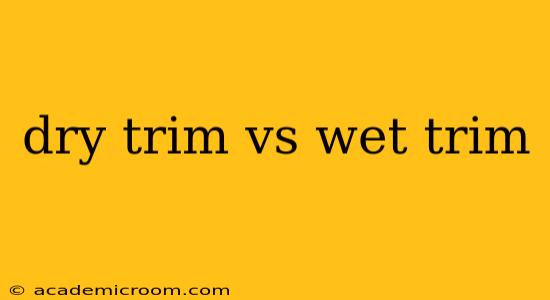Choosing between dry trimming and wet trimming your cannabis buds is a crucial decision that impacts the final product's quality, yield, and overall smoking experience. This comprehensive guide will delve into the nuances of each method, helping you make an informed choice based on your priorities and resources.
What is Dry Trimming?
Dry trimming, as the name suggests, involves trimming the cannabis plant after it has been dried and cured. This typically takes place several days or weeks after harvesting, once the moisture content has reduced significantly. This method preserves more of the trichomes, the tiny, resin-producing glands responsible for the plant's potency and aroma.
Advantages of Dry Trimming:
- Higher Trichome Retention: Because the plant is dry, the trichomes are less prone to breakage and loss during the trimming process. This results in a more potent and flavorful end product.
- Easier Handling: Dry leaves are brittle and easier to remove, making the trimming process less messy and potentially faster for experienced trimmers.
- Improved Curing: Some argue that the curing process is enhanced with dry trimming, allowing for a more even distribution of moisture and a smoother final product.
Disadvantages of Dry Trimming:
- Time-Consuming: Drying the cannabis plant adds significant time to the overall process, which can be a drawback for commercial growers.
- More Labor Intensive: While the actual trimming may be easier, the drying process requires careful monitoring and attention to prevent mold or rot.
- Potentially Lower Yield: Some growers report slightly lower yields with dry trimming due to trichome loss during the drying process.
What is Wet Trimming?
Wet trimming, conversely, involves trimming the plant before it is dried and cured, while it's still fresh and moist. This method is often preferred by large-scale commercial growers due to its efficiency.
Advantages of Wet Trimming:
- Faster Processing: Wet trimming significantly speeds up the overall process, allowing growers to quickly move through large harvests.
- Less Labor Intensive (in terms of time): While it might require more people for a large-scale operation, the trimming itself can be quicker because the leaves are more pliable.
- Potentially Higher Yield: Some growers believe that wet trimming minimizes trichome loss because the plant is still hydrated.
Disadvantages of Wet Trimming:
- Higher Risk of Mold: Wet leaves are more susceptible to mold and rot, requiring meticulous attention to hygiene and proper drying conditions.
- Trichome Loss: Although some believe wet trimming preserves trichomes, there's a higher potential for accidental loss during this process due to the moist, sticky nature of the plant.
- Less Flavorful End Product (sometimes): Some report that the cured buds may have a slightly less intense flavor and aroma compared to dry-trimmed cannabis.
Which Method is Better? Dry Trimming vs. Wet Trimming: The Verdict
There's no single "better" method; the ideal choice depends on individual priorities. Dry trimming generally yields a higher quality product with more retained trichomes, but it requires more time and patience. Wet trimming prioritizes speed and efficiency but carries a greater risk of mold and potentially lower quality.
Consider these factors when making your decision:
- Scale of Operation: For large-scale commercial operations, wet trimming's speed and efficiency are often paramount.
- Desired Quality: If preserving trichomes and maximizing flavor are top priorities, dry trimming is the better choice.
- Experience Level: Dry trimming might be better suited for experienced growers, while wet trimming is more forgiving for beginners.
- Available Resources: Adequate space for proper drying is crucial for both methods, but particularly important for dry trimming.
Frequently Asked Questions (FAQs)
How long does it take to dry trim cannabis?
The drying time depends on several factors including humidity and temperature but generally takes several days to a couple of weeks. Trimming itself is then added on top of this.
How long does it take to wet trim cannabis?
Wet trimming is significantly faster than dry trimming. A large harvest might take several days but is considerably quicker than the combined drying and trimming process of the dry method.
Can I mix wet and dry trimming techniques?
While uncommon, you could theoretically trim some areas wet and other areas dry, but this approach may not yield consistent results.
What tools do I need for wet and dry trimming?
Both methods require sharp trimming scissors or shears. For wet trimming, you may also want gloves to prevent sticky hands. A clean workspace is crucial for both.
By carefully considering the advantages and disadvantages of each method and addressing the key factors above, you can determine the best approach for your specific needs and achieve a high-quality cannabis harvest. Remember that consistency and attention to detail are key to success, regardless of the method you choose.
